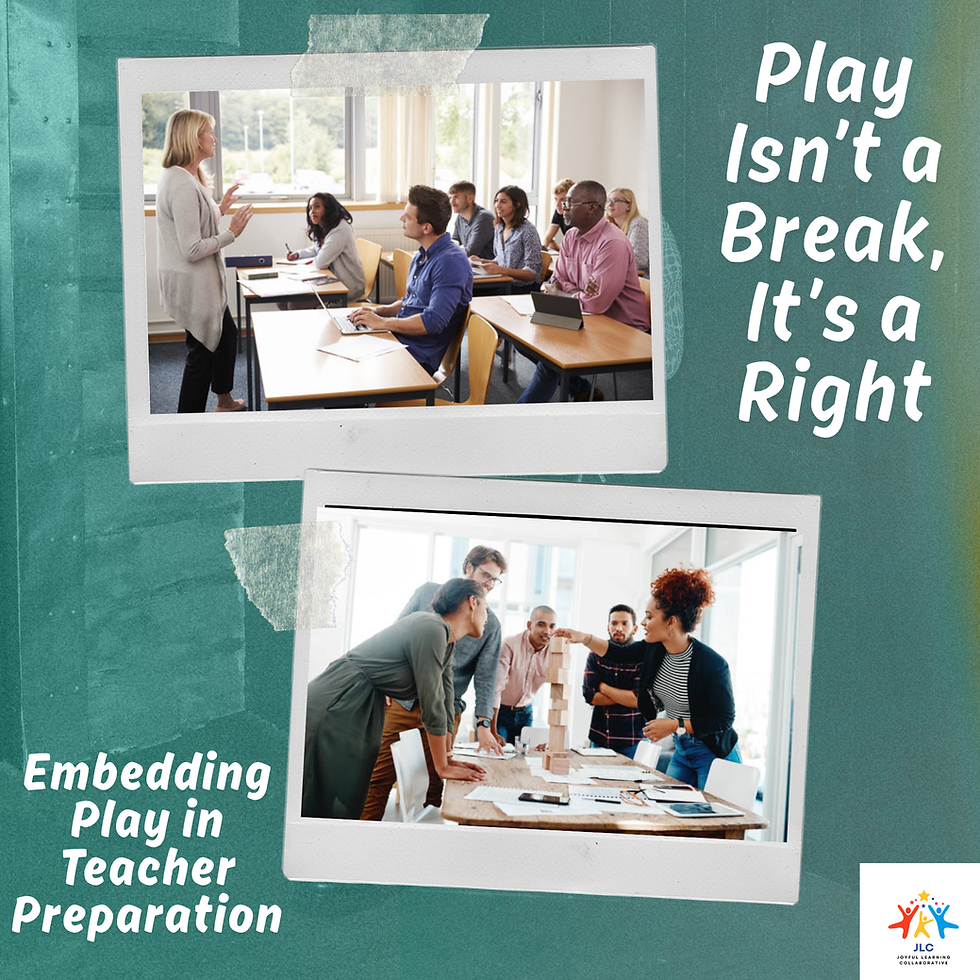Play Isn’t a Break, It’s a Right: Embedding Play in Teacher Preparation
- Annemarie Kaczmarczyk

- Jun 26
- 2 min read

In many elementary classrooms, play is something that happens after the 'real' learning is done. This might look like indoor free play with blocks and other materials, or time spent outside running around with classmates. This type of play is often implemented as unstructured free time with little to no academic content connections. But what if play was the learning? Despite research on play as a powerful learning tool, teacher preparation programs often neglect it beyond early childhood settings.
While various teacher preparation programs have implemented play-based learning experiences within their courses, most of these experiences do not exist in programs focused solely on elementary classrooms (K-5). Additionally, intermediate classrooms (3-5) tend to face the least amount of play integration due to rigorous testing and the time and pressure needed for teachers to prepare these students for testing. For some reason when we step out of the primary classroom (K-2), we step out of our desire to continue creating spaces where students can engage in playful experiences to foster their learning.
There is no doubt that engaging in play-based learning experiences can help ALL students across elementary classroom settings. Tapping into play allows teachers to not only focus on content instruction, but creates spaces where equity can thrive. Play honors diverse ways of knowing, expression, and cultural traditions. Research has shown that these rigid, test-driven models of instruction disproportionately impact marginalized students. With so much research pointing towards the success and benefits of play-based learning, why do we still struggle to see it come to fruition in elementary classrooms?
One possible answer is that while teacher preparation programs focused on elementary classrooms may assign readings and assignments on play-based learning, teacher candidates aren’t engaging in play themselves. Most teacher preparation programs inadvertently emphasize classroom management, standards, and accountability over imagination and joy. These programs also tend to overlook playful pedagogies beyond early childhood education. A quick search for “play-based learning” yields hundreds of articles and resources, most of which focus exclusively on early childhood settings. This oversight of bringing playful pedagogies into elementary education teacher preparation programs leads novice teachers to enter classrooms without the tools, or the confidence, to integrate play. If we don’t teach teachers to play, how can we expect them to teach through play?
Elementary education teacher preparation programs must work to purposefully embed play into methods courses. Play must be framed as academic and rigorous, not frivolous or unstructured. It is not enough for teacher candidates to design and test playful lessons. They themselves must be engaged in playful pedagogy. Elementary education faculty can facilitate this by designing course assignments and tasks around play experiences for teacher candidates. Faculty can integrate simulations, improvisation, game design, or story-building in coursework. They can also encourage culturally responsive play by inviting storytelling, movement, and community-based practices from teacher candidates’ lived experiences.
Teacher educators must reframe play as both a pedagogical tool and a matter of justice within their own methods courses. Play should be made visible and valued across syllabi, assessments, and fieldwork. It should not be seen as an add-on, but rather a foundational practice. If we want teachers to foster curiosity and joy in their classrooms, shouldn’t we prepare them in the same spirit?




Comments